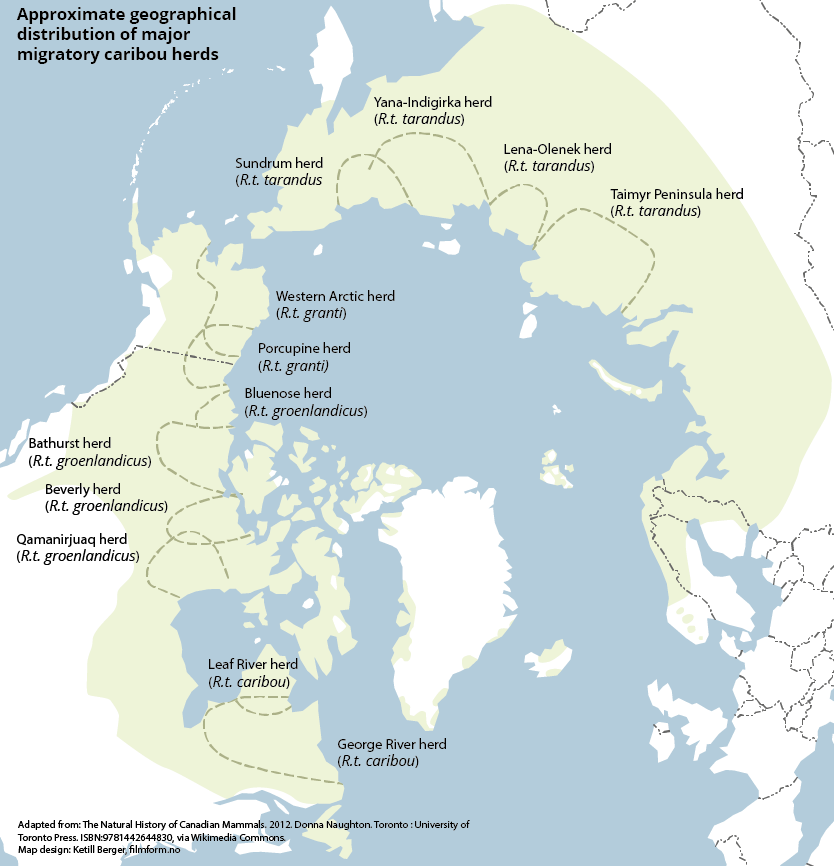Photo: © GaryAndJoanieMcGuffin.com / WWF-Canada
Are migrating caribou losing the collective memory they rely on to survive?
For some time now, constructing an effective conservation strategy for caribou has been like trying to finish a puzzle while missing a piece that is essential to seeing the full picture—in this case, the missing piece is the concept of collective memory. As ANNE GUNN and DON RUSSELL explain, scientists are just beginning to slot this piece into place.
We’ve long known that caribou are social animals: we nearly always see them in large groups flowing along their migratory pathways. But until recently, we didn’t appreciate how migratory tundra caribou learn and exchange information within those groups—not only at a given point in time, but over the course of generations.
We now suspect that collective memory is what helps the caribou cope when foraging conditions are unfavourable. For example, when freezing rain locks up vegetation in their usual feeding areas, the caribou can draw on a pool of shared memories to find alternative areas where they have succeeded during similar challenges in the past. By the same token, we think collective memory helps caribou know where and when to start migrating to their traditional calving grounds.
Wildlife science has been slow to recognize how memory and social learning contribute to individual fitness and how animals maintain and share that knowledge over generations. Only in the last decade or so have we started to see scholarly descriptions of social learning during migration, as well as an emerging recognition that such socially learned, long-term behaviour patterns—what we call culture—are shared within animal communities.
© Wild Wonders of Europe / Peter Cairns / WWF
Comprehending collapses
Unfortunately, our failure to appreciate caribou as social beasts has influenced how we have dealt with declines in herd populations and conservation decisions in the past. Over the last 20 years, we have witnessed a decline in migratory tundra caribou populations. But even though we’ve long known that caribou numbers cycle over decades, we didn’t anticipate declines and didn’t react to them early enough. If we had we listened—really listened—to Indigenous elders’ accounts of caribou retreats, we would not have waited so long to act.
Overall, among 22 migratory tundra herds around the Arctic, all but two have declined from their peak numbers in the 1990s. The Russian migratory tundra wild reindeer have declined by 64 per cent, from 1.4 million to about half a million. Alaska’s three coastal herds have declined by 45 per cent, although by 2017, two herds were starting to recover. (An exception is the Porcupine herd, which has doubled in size since 2001, reaching 218,000 caribou in 2017.)
In Canada, migratory tundra caribou are down a shocking 65 per cent—from 5.4 to 1.6 million—and most herds are marooned at perilously low numbers. Some have even collapsed by 98 per cent. Indigenous elders cannot recollect such low levels. Why the numbers dropped so steeply under our watch is a complicated question, but Indigenous People’s grief is intense and unmistakable.
When caribou herds collapse, understanding their social behaviour becomes critical. We now recognize that the numbers of cows on traditional calving grounds dropped too low to provide safety in numbers during calving, leading some cows to abandon their traditional calving grounds and migrate to neighbouring ones. The level of abandonment took wildlife managers by surprise, given that cows typically maintain fidelity to their traditional grounds. They have a good reason for doing so: in unfamiliar areas, fewer of them survive.

© Ketill Berger
Preserving caribou’s collective memories
The low numbers of caribou that we are seeing now align with how Indigenous elders have described cyclical changes in caribou migrations. The implication is that when their numbers recover, the caribou will resume many of their customary migration routes. But here’s the worry: caribou numbers are so low in some herds that there may not be enough knowledgeable caribou left to guide the others.
We now suspect that collective memory is what helps caribou cope when foraging conditions are unfavourable.
A sense of place—the persistence of calving grounds over generations, for instance—is based on social behaviour, which suggests that caribou can move efficiently through their memory-scape. We have the broad outlines of how this works, but there’s still a piece missing in the conservation puzzle: we are trying to figure out whether and how we can we fast-track caribou’s recovery from these cyclical collapses before their collective memories—the invaluable knowledge gleaned from experience and social learning over generations about how to negotiate the complex geographies of their physical world—are irretrievably lost.
The need for a solution is urgent as the climate warms and our human footprint expands within their habitat.
By Anne Gun and Don Russell
Canadian caribou biologists